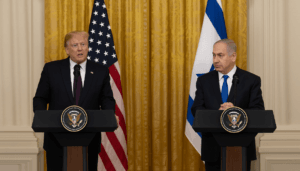Shocking Trump-Netanyahu Meeting: 5 Urgent Issues to Watch in Explosive White House Talks
President Trump is set to meet Israeli Prime Minister Benjamin Netanyahu at the White House on Monday to discuss the intensifying military campaign in Gaza and newly imposed U.S. tariffs on Israel and other countries. The meeting comes as Israel advances its ground operations, establishing new corridors like the Morag Corridor to isolate Rafah and pressure Hamas into releasing remaining hostages. Netanyahu also plans to raise issues like Israeli-Turkish ties, the Iranian threat, and international legal challenges.
The offensive has prompted sweeping evacuation orders and worsened humanitarian conditions in Gaza, with the U.N. reporting over 280,000 newly displaced Palestinians. Hamas warns that the escalating conflict endangers hostages, refusing to move them from evacuation zones. They demand a lasting ceasefire and the release of Palestinian prisoners in exchange for the remaining captives. Israel defends its actions, claiming to have killed 20,000 militants, while Gaza’s Health Ministry reports over 50,000 Palestinian deaths, mostly women and children.
As global attention turns to the Trump-Netanyahu summit, the stakes remain dangerously high for both political leaders and the millions affected on the ground.

Shocking Trump-Netanyahu Meeting: 5 Urgent Issues to Watch in Explosive White House Talks
U.S. President Donald Trump is set to meet Israeli Prime Minister Benjamin Netanyahu at the White House on Monday, as confirmed by sources to CBS News. The leaders plan to address Israel’s ongoing military operations in Gaza and the recent U.S. tariffs imposed on Israel and other nations. Netanyahu’s office also highlighted additional topics, including Israel’s ties with Turkey, Iran’s regional influence, and investigations by the International Criminal Court (ICC).
The Israeli government expressed appreciation for Trump’s invitation, emphasizing the close rapport between the two leaders. Netanyahu was notably the first foreign leader to meet Trump following the announcement of global tariffs, mirroring his role during Trump’s first presidential term. This marks their second meeting since Trump’s re-election. Their previous discussion in February 2024 included Trump’s controversial proposal for the U.S. to oversee Gaza’s transformation into a tourism hub dubbed the “Riviera of the Middle East.”
Israel Escalates Gaza Offensive
Ahead of the meeting, Israel has expanded its military campaign in Gaza. Officials claim the goal is to pressure Hamas to release the remaining hostages and dismantle the group’s control. Recently, Netanyahu announced the creation of the “Morag Corridor,” a new military route in southern Gaza designed to isolate Rafah—a city under evacuation orders—from the rest of the territory. Named after a former Israeli settlement, the corridor stretches east to west across Gaza.
Israel also reclaimed control of the “Netzarim Corridor,” a strategic zone dividing northern Gaza (including Gaza City) from central and southern areas. Netanyahu compared the Morag Corridor to the “Philadelphi Corridor,” a security buffer along Gaza’s border with Egypt established years earlier.
Hostage Crisis and Ceasefire Demands
Hamas has warned that Israel’s intensified strikes endanger the lives of hostages still held in Gaza. A spokesperson for Hamas’ military wing stated that roughly half of the remaining captives are in evacuation zones targeted by Israeli forces. The group refuses to relocate them, insisting it will only release hostages—59 in total, with 24 believed to be alive—in exchange for a permanent ceasefire, Israel’s complete withdrawal from Gaza, and the release of Palestinian prisoners. Hamas has rejected calls to surrender or leave the region.
Since Israel ended a U.S.-mediated ceasefire last month, nearly 280,000 Palestinians have been displaced, according to the United Nations. Aid organizations accuse Israel of blocking food, fuel, and humanitarian supplies, potentially constituting a war crime. Israel disputes this, arguing that sufficient aid entered Gaza during the truce to support its 2 million residents.
Conflict Toll and Ongoing Tensions
The war began after Hamas attacked southern Israel on October 7, 2023, killing approximately 1,200 people—mostly civilians—and taking 251 hostages. While most hostages were freed through past ceasefire agreements, Israel has rescued eight alive and recovered several bodies.
Gaza’s Health Ministry reports over 50,000 Palestinian deaths, more than half of them women and children. Israel claims around 20,000 Hamas fighters have been killed but has not provided detailed evidence.
Key Issues on the Table
- Gaza’s Future: Trump’s earlier proposal to turn Gaza into a tourist destination remains contentious. Netanyahu’s focus on military control contrasts with international calls for a political solution.
- Humanitarian Crisis: Aid shortages and displacement continue to draw global criticism. Rights groups urge Israel to allow unrestricted aid access.
- U.S.-Israel Relations: Tariffs and shared security concerns, particularly regarding Iran, will shape discussions. Trump’s support for Netanyahu’s policies has drawn both praise and backlash.
The meeting underscores the complex dynamics of the Gaza conflict, balancing military strategy, humanitarian needs, and diplomatic pressures. With both leaders prioritizing their respective agendas, the outcome could influence the trajectory of the war and regional stability.
You must be logged in to post a comment.